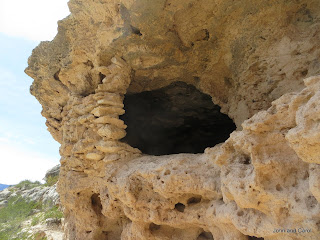This is one of the rooms in the commanding officer's home. It is nicely furnished.

The bachelor officers lived in a more spartan style.

The surgeon's quarters also included a surgery or operating room. I'm glad I didn't need surgery back then. All recuperating surgery patients and those who were ill were housed in a hospital at another location.

All of these buildings are located on one side of the parade grounds.

Following our tour, we stopped at Babe's Roundup BBQ to pick up lunch. We were taking it back to the RV park to spend time with the managers. Babe's has interesting decorations inside. This is one wall of the restaurant.

On Monday, when we checked in to Zane Grey RV Park, one of the managers walked up as we approached the office and said, "You don't recognize me, do you?" The voice gave him away. We volunteered at Lathrop State Park in Colorado with Norm and Nan for two summers, 2009 and 2010. We had no idea they were now working at this park.

After lunch, we drove a mile or two down the road from Zane Grey to take a hike Nan had recommended. Near the top of one of the nearby hills, there are a number of cavates that were used by early Native Americans. Cavates are small caves that are scooped out to provide space for living and storage. Here is a view from near where we parked the truck. It is a pretty rugged path up the hill to the top.

This is what we saw when we were nearly there.

Here are a couple of the cavates. The second one has a blackened roof from the cooking and heating fires that had been built there 700 to 900 years ago, most likely.


The archaeology sites are protected by federal law but not in any other way. But they seem to be largely undisturbed. We saw lots of pieces of broken clay pots, both plain red and black. That is the style of pottery made by the Sinagua people. Here are several potsherds, with John's hiking boot in one photo and his finger in the next for a size reference.


We climbed to the top of the mesa to see the ruins of another structure. There is not much to see except some sections of stone walls. There were several rooms in this structure.

This is the view looking down from the mesa top into the Clear Creek valley. That line of trees shows where the creek runs. That was probably where the people who had lived under and on top of this mesa obtained their water. That is a long way to carry it.

We found one spot of color on the mesa top, these bright red indian paintbrush were in bloom.

It was a great hike. Thanks for the suggestion, Nan!

No comments:
Post a Comment